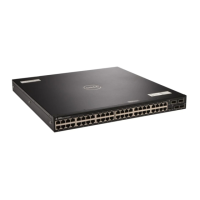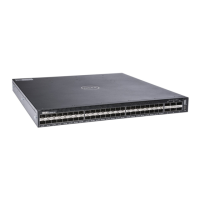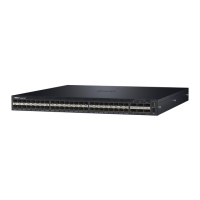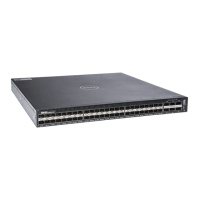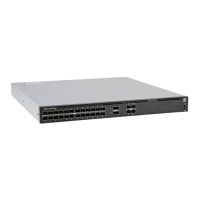When configuring lossless queues on a port interface, consider the following points:
• By default, no lossless queues are configured on a port.
• A limit of two lossless queues is supported on a port. If the number of lossless queues configured
exceeds the maximum supported limit per port (two), an error message is displayed. Reconfigure the
value to a smaller number of queues.
• If you configure lossless queues on an interface that already has a DCB map with PFC enabled (pfc
on), an error message is displayed.
Step Task Command Command Mode
1 Enter INTERFACE Configuration mode.
interface
{tengigabitEthernet
slot/port |
fortygigabitEthernet
slot/port}
CONFIGURATION
2
Open a DCB map and enter DCB map
configuration mode.
dcb-map name
INTERFACE
3
Disable PFC.
no pfc mode on
DCB MAP
4
Return to interface configuration mode.
exit
DCB MAP
5
Apply the DCB map, created to disable the
PFC operation, on the interface
dcb-map {name |
default}
INTERFACE
6
Configure the port queues that still function
as no-drop queues for lossless traffic. For
the dot1p-queue assignments.
The maximum number of lossless queues
globally supported on a port is 2.
You cannot configure PFC no-drop queues
on an interface on which a DCB map with
PFC enabled has been applied, or which is
already configured for PFC using the pfc
priority command.
Range: 0-3. Separate queue values with a
comma; specify a priority range with a dash;
for example: pfc no-drop queues 1,3 or pfc
no-drop queues 2-3 Default: No lossless
queues are configured.
pfc no-drop
queuesqueue-range
INTERFACE
Priority-Based Flow Control Using Dynamic Buffer
Method
Priority-based flow control using dynamic buffer spaces is supported on the S4820T platform.
In a data center network, priority-based flow control (PFC) manages large bursts of one traffic type in
multiprotocol links so that it does not affect other traffic types and no frames are lost due to congestion.
296
Data Center Bridging (DCB)
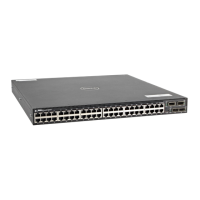
